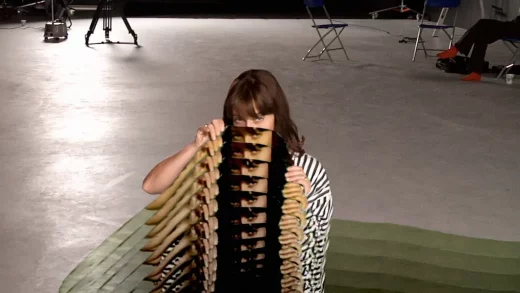:format(webp)/https://www.thestar.com/content/dam/thestar/entertainment/stage/review/2023/07/08/hadestown-heads-to-some-dark-and-moody-places/_2048_nathan_lee_graham_in_hadestown_north_american_tour_2022_ph.jpg)
Hadestown
Music, book, and lyrics by Anaïs Mitchell, developed with and directed by Rachel Chavkin, choreographed by David Neumann, music supervision and vocal arrangements by Liam Robinson. At the Royal Alexandra Theatre, 260 King St. W., through Aug. 20. Mirvish.com or 1-800-461-3333
“Way down under the ground”: It’s not somewhere you expect a major-hit Broadway musical to go.
But even its title cues that “Hadestown” heads to some dark and moody places.
Anaïs Mitchell’s celebrated tuner blends ancient myths, musical influences from roots to show tunes, and bravura stagecraft into a celebration of the capacity of love to pierce briefly through the oppressive weight of capitalism.
The show was nominated for 14 Tony Awards in 2019 and won eight, including Best Musical and Best Score. Mirvish Productions is hosting the show’s North American tour at the Royal Alex for seven weeks before it moves on to several more Canadian cities including Edmonton, where it ran in 2017 as part of its more than a dozen-year development period.
In keeping with current Broadway trends, the show’s style is highly presentational, by which I mean it delivers its material as storytelling rather than inviting the audience into a fictional universe. It’s a show that revels in the fact that it’s putting on a show. In the first number, a narrator named Hermes (Nathan Lee Graham) introduces the major characters and the general direction in which the story is heading: down a “Road to Hell.”
Its distancing devices worked effectively on me, perhaps to a fault: I found myself more impressed than moved, but many others seemed swept away. An Act Two moment in which the magical appearance of a red rose affirms the power of love led to a collective gasp and sigh.
Director Rachel Chavkin extends her reputation here for creating intoxicatingly detailed stagings intended to draw audiences into an overall environment and mood (the musical that made Chavkin’s name on Broadway, “Natasha, Pierre & the Great Comet of 1812,” is getting a Toronto production from Crow’s Theatre and Musical Stage Company later this year).
Rachel Hauck’s set was inspired by New Orleans venues including Preservation Hall and evokes both a speakeasy and a Greek amphitheatre, places where the community assembles to bear witness. Eric Kang’s seven-person band plays onstage, sitting on risers looking down on the action. The show immediately establishes its bluesy mood with an opening trombone solo performed by Emily Fredrickson, whose amazing musical capacities were one of the evening’s highlights.
Via Hermes’ narration, we’re introduced to the two intertwined myths that make up the plot: the love story between aspiring songwriter Orpheus (J. Antonio Rodriguez) and waifish Eurydice (Hannah Whitley), and the fraught union of Persephone (Maria-Christina Oliveras) and Hades (Matthew Patrick Quinn).
Part of the fun of the show for theatre buffs will be spotting internal references to other musicals: with his guitar slung over his shoulder, continually distracted by the one great song he’s trying to write, Orpheus echoes Roger in “Rent,” while Graham’s sinuous, expressive Hades evokes Ben Vereen as the Leading Player in “Pippin.” The use of stand mics put me in mind of “Girl From the North Country” and helps set the action around the time of the Great Depression.
The structure is that of a song cycle, with relatively little spoken dialogue. Two choruses weave in and out of the action: a girl group-like trio of Fates (Dominique Kempf, Belén Moyano and Nyla Watson) and a five-person ensemble who start out as community observers and transform into downtrodden, depersonalized workers when the action moves, late in Act One, to Hades’ underworld lair.
This is accomplished by a monumental set and lighting shift: the walls shake, a wall of LEDs illuminates, fog pours in and the disconcertingly believable effect is that the whole stage is moving downwards. That was all mightily impressive, but the added effect of light beams sweeping directly into the audience’s eyes pushed this sequence over the edge from intoxicating to pummeling.
Quinn’s extraordinarily resonant voice and commanding stage presence as the pinstriped, pompadoured boss man Hades made his the standout performance. Persephone’s role in the story is crucial: she spends six months aboveground and is a force of light and positivity, telegraphed wonderfully by her initial bright green costume (the delightful designs are by Michael Krass). The conflict for her character is to resist Hades’s power and keep her connection to the living world. While Oliveras sings wonderfully, her performance does not fully convey the character’s inner turmoil.
There’s also a spark missing between Rodriguez’s Orpheus and Whitley’s Eurydice: individually beautifully sung, the performances don’t fully convince of a passionate connection, though this is partially attributable to the directorial choice to have performers play out to the audience rather than to each other.
Chavkin’s physical staging involves a number of affecting movement sequences in which David Neuman’s choreography and a stage revolve evoke the oppressive world of subjugation under Hades’ rule. All technical and staging elements converge in the climactic sequence of Orpheus and Eurydice’s journey back up to Earth, so that it really seemed as if they were moving through space and time when in fact they were mostly walking in place.
It’s largely Mitchell’s score that has helped the musical gain a youthful fan base, and her facility to bring multiple musical influences from jazz to blues to roots into a credible musical theatre score is indeed prodigious (her surprise appearance onstage on opening night to sing an encore with the cast was a highlight). It’s a cast album I’ll be returning to and “way down, Hadestown” is one heck of an earworm.
JOIN THE CONVERSATION
does not endorse these opinions.



